It was explained that a significant portion of the VVP's Rs 48 billion expenditure over three years would be allocated to building and improving road connections. It was disclosed that there were currently 113 roads approved by the Ministry of Home Affairs (MHA), with the major projects concentrated in Arunachal Pradesh (105 roads), Uttarakhand (5 roads), and Sikkim (3 roads). The construction efforts encompassed both roadways and steel bridges, with an estimated cost of Rs 20 million per kilometre, indicating substantial investment in infrastructure to ensure robust connectivity.
Regarding project specifics, it was outlined that the Uttarakhand Pithoragarh Project was situated in the Pithoragarh district, Uttarakhand, India, with a total road length of 43.96 km and a total cost of Rs 1.19 billion, approximately Rs 20.71 million per kilometre. Similarly, the Sikkim Chungthang-Mangan Project, located in the Chungthang and Mangan blocks, Sikkim, India, encompassed 18.73 km of roads and 350 meters of steel bridges, with a total cost of Rs 960 million, approximately Rs 50.03 million per kilometre.
Strategic considerations were also discussed, indicating that India's efforts in constructing more infrastructure under the VVP were part of a broader strategic response to China's construction of "moderately prosperous" Xiaokang villages along the Line of Actual Control (LAC), particularly in areas facing Uttarakhand, Sikkim, and Arunachal Pradesh. It was noted that India sought to fortify its border regions by facilitating livelihoods, enhancing surveillance capabilities, and reinforcing border control measures.


